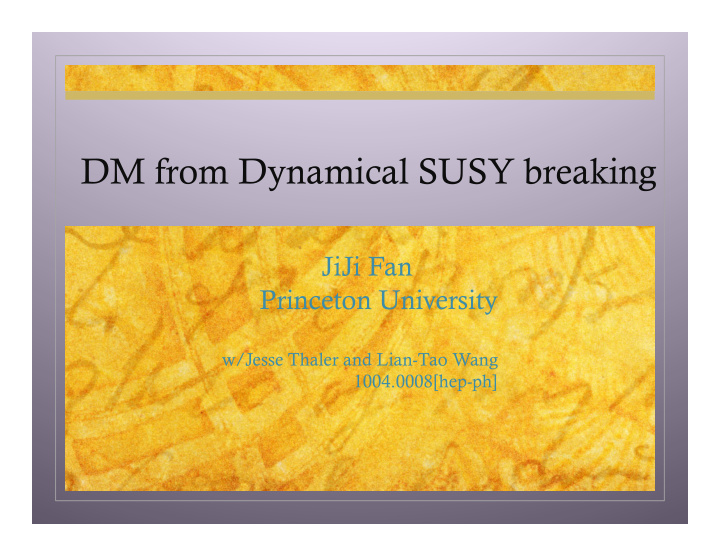



DM from Dynamical SUSY breaking JiJi Fan Princeton University w/Jesse Thaler and Lian-Tao Wang 1004.0008[hep-ph]
Motivation Leading paradigm for the origin of DM is the thermal freezeout of stable massive particle. Relic abundance of cold DM is determined by Only the ratio is fixed! κ 4 � σ v � = 1 m 2 8 π DM − (100 GeV − 1 TeV ) (10 − 100 TeV ) m DM ← − → √ − (0 . 1 − 1) ( 4 π − 4 π ) κ ← − → ? WIMP Feng, Kumar 0803.4196
Only the ratio is fixed! κ 4 � σ v � = 1 m 2 8 π DM (100 GeV − 1 TeV ) (10 − 100 TeV ) m DM − → √ (0 . 1 − 1) ( 4 π − 4 π ) κ − → ? WIMP Strongly-coupled low-scale dynamical SUSY breaking in gauge mediation (always don’t have a viable cold DM in the visible sector)
Framework : Basic Gauge mediation Setup: New ingredients: Λ ~ (10 – 100) TeV Accidental global symmetry: baryon number, Dynamical SUSY sector flavor symmetry; DM candidate (Quasi)-stable composites w/ M ~ (10 -100 ) TeV k ~ ( √ 4 π – 4 π ) Spontaneous R-symmetry: R-axion standard model gauge interaction (through messenger loops) Supersymmetric standard model (MSM) sector ( LSP : gravitino )
(Quasi-stable) states Lightest states charged under some unbroken global symmetries are cold DM candidates; Accidental global symmetries could be broken at high scale, e.g., unification/Planck scale. Dim-6 operators leads to a DM lifetime: � 4 � 10 TeV � 5 τ DM ∼ 8 π M 4 � M ∗ ∼ 2 × 10 25 sec ∗ 10 17 GeV m 5 m DM DM Required lifetime to explain electon/positron anomalies in cosmic rays! (Arvantitaki, Dimopoulos, Dubovsky, Graham, Harnik and Rajendran 0812.2075, 0904.2789…)
Portal to the MSM: R-axion mass: From supergravity: R- axion � 3 a ∼ Λ 3 � Λ m 2 ∼ (10 MeV ) 2 Spontaneous R breaking is 100 TeV M Pl always associated with SUSY breaking . e. g. : ADS criteria From additional explicit breaking: R – axion keeps DM in thermal equilibrium with MSM Dim-5 ops suppressed by (10 9 -10 18 GeV) R-symmetry breaking is also essential to generate gaugino m a ~ (1 MeV – 10 GeV) masses in MSM R-axion coupling
R-axion allowed parameter space ( Mardon, Nomura and Thaler 0905.3749) Lepto-philic DM decays through R-axion portal
An (approximate) unbroken global symmetry under which DM is charged A spontaneously broken R- symmetry, resulting in an R-axion
A model DSB with a dynamical superpotential: e.g, 3-2 model, 4-1 model (w/o any DM candidate in the DSB sector) Needs to extend the global symmetry structure to allow for a DM Setup (a 6-1 model) SU(3) SU(2) W cl = λǫ 123 A αβ ¯ α S 2 ) + η 3 F α ¯ Add superpotential α ¯ β + η 1 F α ( ¯ α S 1 + ¯ F 1 F 2 F 1 F 2 F 3 α S 3 , Below SU(6) dynamical scale, the gauge singlet composites are X ∼ SF ¯ (¯ : 2 + 1 ) 2 F H ∼ A ¯ F ¯ (¯ : 2 + 1 ) 2 F Y ∼ F ¯ F Pf A : ( 2 + 1 ) − 6
In composites, full superpotential is 1 Y 1 + X 3 � X 3 2 Y 2 3 + α Λ 4 � W = ˜ λ Λ 2 H 3 + ˜ η 1 Λ 2 η 2 Λ 2 X 3 + ˜ Y H , Y 3 √ added dynamical generated E.o.ms cannot be satisfied simultanenously: SUSY R-charged composites get VEVs: R DM candidates: lightest composites charged under the unbroken global SU(2) NDA tells: couplings ~ 4 π mass ~ Λ
DM could also arise from other DSB scenario: e.g, vector-like model with a quantum moduli space. We have focused on one-scale DSB model: DM mass is comparable to the dynamical scale; There are DSB models containing stable states parametrically lighter than the DSB scale, e.g., pseudo-GB or pseudo moduli. It’s hard to achieve right amount of relic abundance for those states.
An alternative mechanism that gauge mediated SUSY breaking could have cold DM candidate: DM from the DSB sector Minimal requirements to realize the mechanism already requires non- trivial structure of DSB sector; necessary to develop more tools to understand strongly-coupled SUSY theory. Additional probe of the dark sector from the light R-axion state
Recommend
More recommend